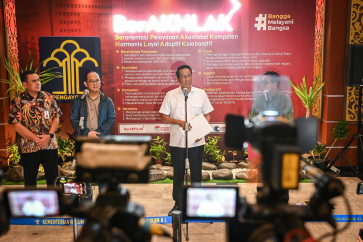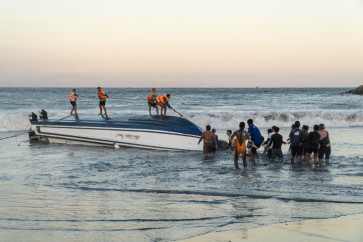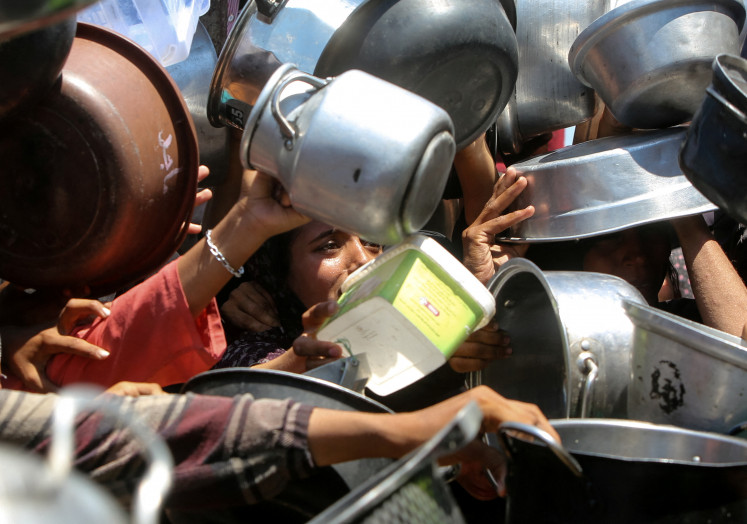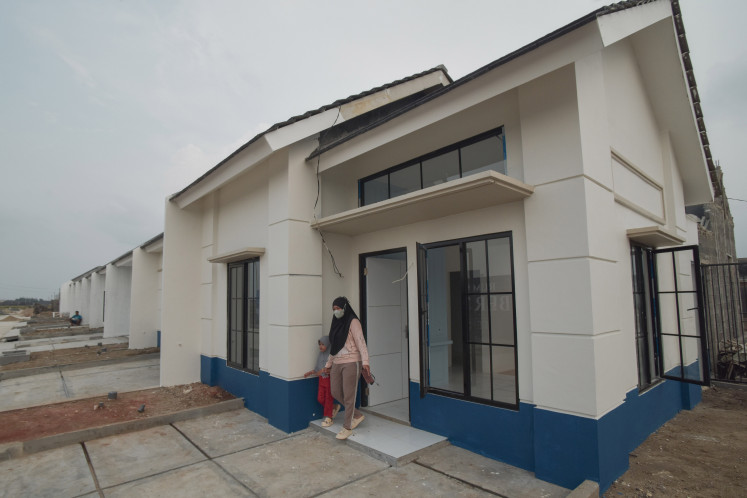Popular Reads
Top Results
Can't find what you're looking for?
View all search resultsPopular Reads
Top Results
Can't find what you're looking for?
View all search results'Endek': An almost forgotten cloth
A weaver tries to fix tangled yarns on the hand loomâs shuttle
Change text size
Gift Premium Articles
to Anyone
A weaver tries to fix tangled yarns on the hand loom's shuttle.
One only has to pass Blahbatuh bridge ' the one with an old Chinese temple below it ' and turn right at the first intersection to find Putri Ayu, a medium-scale weaving plant that produces the exclusive endek cloth worn by the world's leaders at the recent APEC Summit in Nusa Dua, Bali.
Had Daily Mail reporter Kieran Corcoran took the time to get out of Nusa Dua and visit this plant, he certainly would not have published his inaccurate piece that claimed the exclusive endek was designed in Bali but produced in China. Neither would he likely have presented the resort island as a 'city', for that matter.
'It took us three months to produce the fabric. One and a half months to color the threads and another 1.5 months to weave it,' plant owner Ida Bagus Adnyana said.
Born into an influential Brahmin family in Tegal, Denpasar and growing up in another Brahmin compound in Sanur, Adnyana pursued a career in several fields before falling in love with the art of creating traditional cloth.
'The patience it requires, the delicate skill a weaver must possess to craft a piece of cloth from hundreds of very long yarns, the comforting beauty a handmade cloth exudes, these are the things that captivated me in the first place,' he said inside his office on the western corner of the huge open hall that houses most of Putri Ayu's handlooms.
There were at least 30 non-motorized handlooms in that hall and the clanking sounds produced by the constant movements of their wefts and warps resonated through the thin walls of Adnyana's office.
A worker at Putri Ayu colors certain sections of threads with specific colors to create endek motifs.
Pictures of Adnyana with the country's dignitaries, including First Lady Ani Yudhoyono and former president Megawati Soekarnoputri, adorned the wall facing the weavers, mostly women and young girls from surrounding villages.
On the wall's opposite side, several trophies were neatly arranged on a wooden cabinet. They spoke of Adnyana's achievements at the local and national level.
The compound used to host a rice mill until Adnyana transformed it into a weaving plant in 1991. It started with the huge open hall and several handlooms.
The plant also boasts several Jacquard looms that can produce the thinnest songket, traditional cloth with intricate motifs of silver or gold threads, in a single day.
A massive building in a Balinese style that stands next to the hall houses several looms and samples of Puri Ayu's endek and songket clothes. Adnyana called it his 'humble store', though it had the qualities of a small museum.
Adjacent to this building is a beautiful, elaborately adorned traditional Balinese house, where Adnyana and his wife, a charming Balinese lady with progressive thoughts on religion and culture, take their afternoon rest.
A gorgeous statue of Saraswati, the goddess of sciences and arts, made of Chinese coins, perches serenely in front of the house, flanked by natural stones bearing Balinese calligraphy.
'I've not done anything magnificent here. I'm doing what I love and I try my best to preserve this beautiful heritage for generations to come.'
It was not an easy task. Traditional fabrics, like endek and songket, were very popular in the 1990s. Their popularity waned when Balinese women shifted their focus to what they wore on the upper parts of their bodies.
Consequently, the kebaya became the gem of the fashion and local women tried to out-style each other by purchasing and wearing the most unique and most expensive kebaya made of French brocade.
Traditional fabrics, along with batik, all traditional clothes usually worn on the lower part of the body, played second fiddle to imported fabric during those years.
Things changed for the better in the late 2000s when UNESCO acknowledged batik as a Masterpiece of the Oral and Intangible Heritage of Humanity. Soon, the country saw a rising interest in these almost forgotten traditional clothes.
In Bali, the regency administrations tried to revive the signature endek of their respective region.
The exclusively -designed Endek for state leaders is inspired by the colors and weapons of Balinese Hinduism's nine primary dignitaries.
'It's still a very difficult task as we lack historical data on the development of endek on this island. We have several hypotheses on the origin and the evolution of endek but we need more scientific-based evidence to prove it,' he said, adding that Gianyar regency administration was sponsoring the publication of a book on endek.
Denpasar city administration took the campaign to revive the traditional cloth one step further by declaring endek the city's official cloth.
The declaration was followed by several concrete steps: Providing training and assistance to the city's weavers, designating one floor at Kumbasari market as the endek emporium, as well as making it mandatory for the city's officials and employees to wear endek shirts on official occasions.
When endek was chosen to be the fabric worn by state leaders attending the APEC Summit, many saw it as the peak of the cloth's revival. For Adnyana, however, taking endek into a new golden age requires more than global exposure.
'Part of the problem lies in the nature of endek cloth itself. Being a hand-woven cloth means it takes time to produce. A handloom can only produce one meter of endek cloth per day. Unfortunately, we have begun to see inexpensive, printed endek entering the market,' he said. 'This will make hand-woven endek less interesting for a large amount of customers and eventually force hand-woven endek into a niche product.'
Another challenge is rampant piracy that sees innovative endek artisans being pushed aside by those who do nothing but copy their designs and then mass-produce them.
'The most important challenge is how to make weaving a profitable profession. Most of my workers are in their late 40s, some have left this job because it cannot sustain them financially, and there is basically no interest in the younger generation to pursue a career in this field,' he stressed.
Endek may have come back from obscurity but its battle to survive and remain popular has just begun.
' Photos by I Wayan Juniarta












